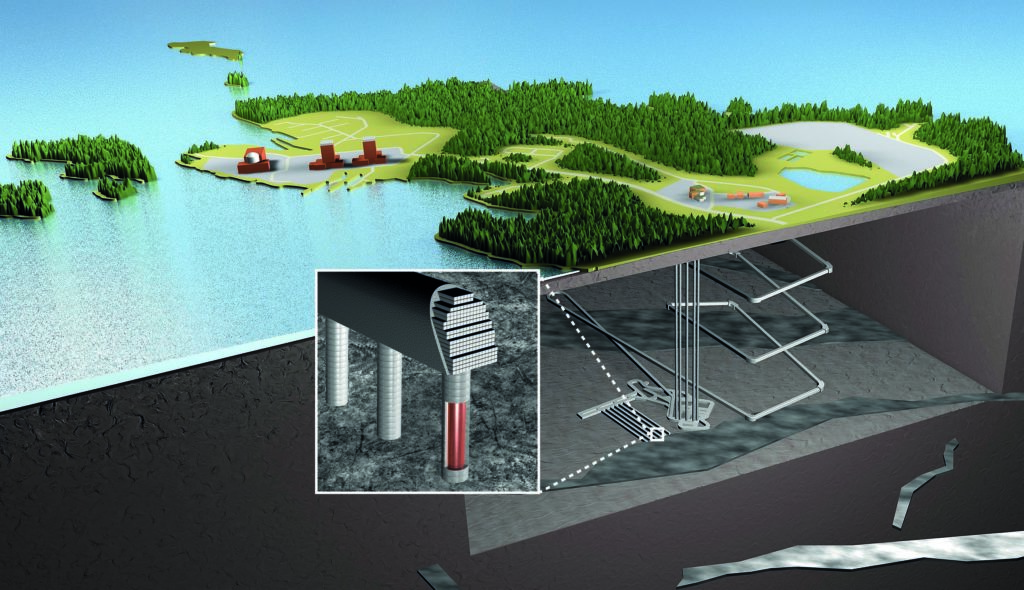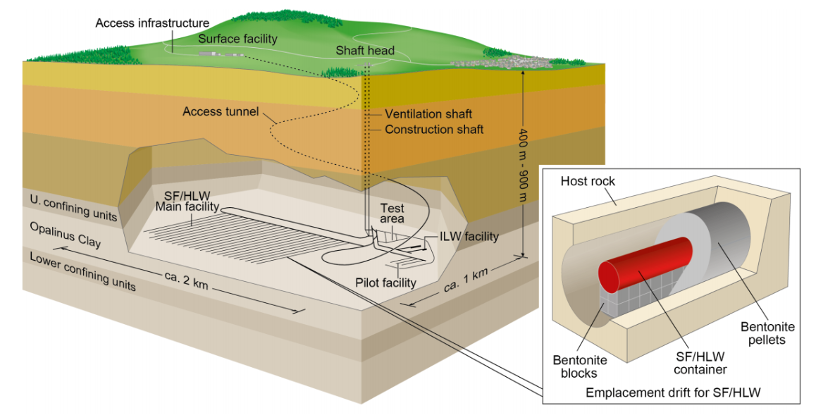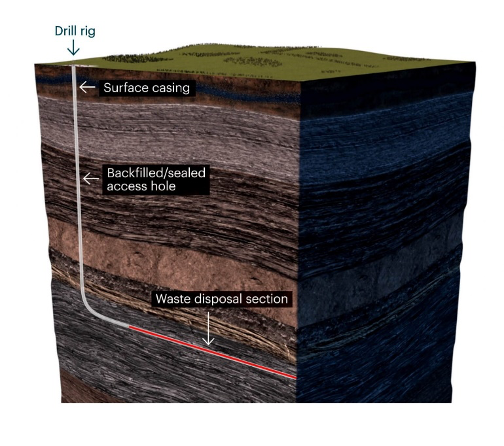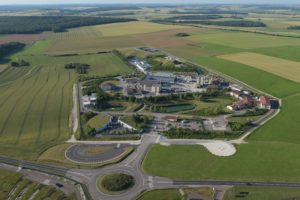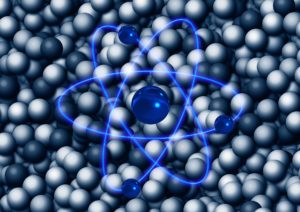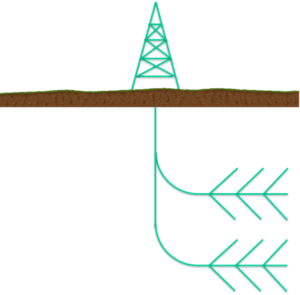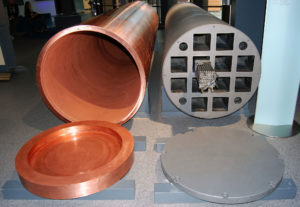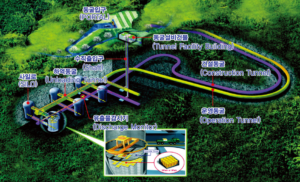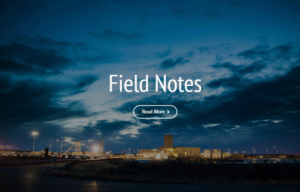Rapidly Growing Amounts of Spent Nuclear Fuel
Since the 1950s, hundreds of nuclear reactors in scores of countries have been producing spent nuclear fuel – some 400,000 metric tons of it. The amount of spent fuel in storage is expected to continue to grow for decades to come.
As of April 1, 2020, there are 442 operational nuclear power reactors in 30 countries and 220 research reactors operating across 53 countries. Along with the sustainable nuclear energy and radioisotope materials they provide to the world, they also produce radioactive waste. The most hazardous portion of the waste is spent nuclear fuel (SNF), or used nuclear fuel, which has accumulated to 400,000 metric tons of heavy metal (tHM) throughout the world as of 2017. On average, the global SNF stockpile increases by 11,300 tHM annually. This will increase 2 – 5% in the short term as 59 nuclear power reactors1There are 50 nuclear power reactors in Europe and 9 nuclear power reactors in US being shut down by 2025 are anticipated to be shut down by 2025 – intensifying the need for countries to make decisions on storage and final disposal.
SNF contains fissile material such as plutonium and uranium which the International Atomic Energy Agency (IAEA) considers as “direct use material” for the manufacture of nuclear explosives. Plutonium in SNF is of proliferation concern because it can be separated from other highly radioactive products by reprocessing technique – a series of physical and chemical processes. Once separated, plutonium loses its lethal protective layer of unshielded SNF as plutonium is not very radioactive (its half-life is 24,000 years). This leaves plutonium at risk for diversion, theft and sabotage. To this end, verifying nuclear material in spent fuel is not diverted from peaceful uses is crucial in assuring the international community that States are upholding their non-proliferation obligations.
Will it even be in the same country in 150 years?
Spent nuclear fuel is dangerous for thousands of years, but borders change and governments rise and fall on much shorter time scales. Storage locations in one country may well find themselves in another country in the future. This poses particular challenges for safeguarding buried nuclear waste.
Spent nuclear fuel will continue emitting high-level of radiation for thousands of years, which presents a challenge not only for long-term SNF management but also for its ownership. Political borders change over time and governance regimes rise and fall. The border between Croatia and Slovenia, for example, shifted 7 times between 1917 to 1991.2Europa Publications, A Political Chronology of Europe, (Abingdon: Routledge, 2003), 235-237; Leopoldina Plut-Pregelj, Carole Rogel, The A to Z of Slovenia (Lanham: Rowman & Littlefield, 2010), xxiii-xxviii. Accordingly, when considering the long timelines of spent fuel storage and disposal, we must also consider that the ownership of SNF buried underground may be affected, and so might SNF management.
Potential changes in spent fuel ownership and management strategies also need to be considered when countries jointly operate nuclear power plants and therefore share the responsibility for waste management. Since 2003, the Republic of Croatia has shared the ownership of the Krško NPP with the Republic of Slovenia. Croatia owns half of spent fuel generated up to expiration of the Krško NPP lifetime.
Changing Borders
Yugoslavia vs. Croatia and Slovenia
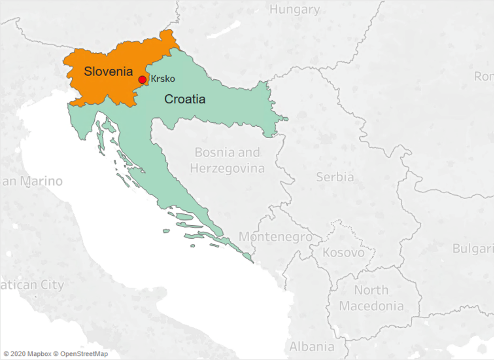 July 1991
July 1991
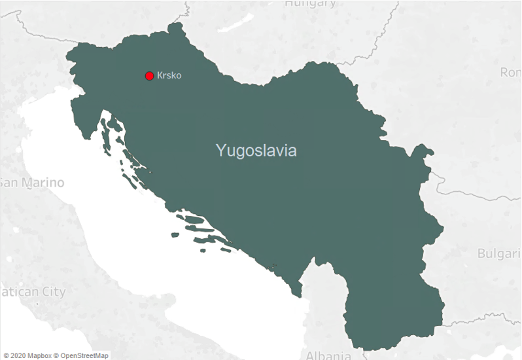 May 1991
May 1991
Drag slider handle to compare.
In June 1991, Croatia and Slovenia declared their independence from Yugoslavia. The Krsko nuclear power plant, which came online in October 1981 and is still the sole plant in Slovenia, is now jointly owned by companies in Croatia and Slovenia. SNF is entirely stored onsite at the plant.
East and West Germany vs. United Germany
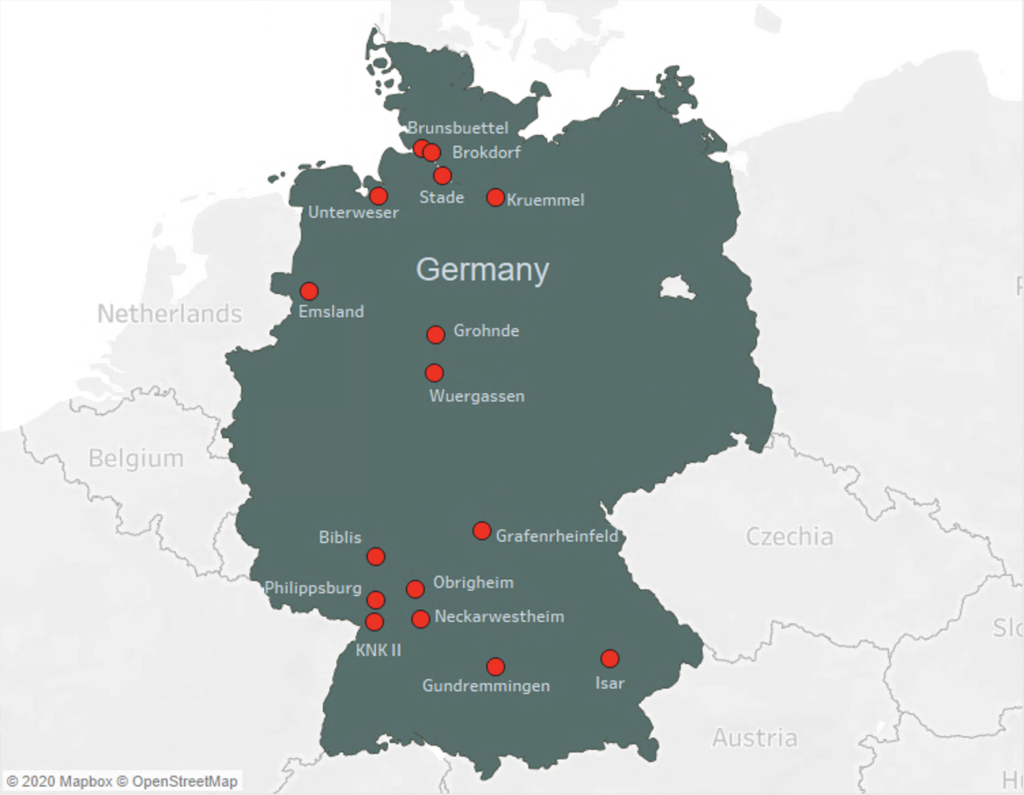 November 1990
November 1990
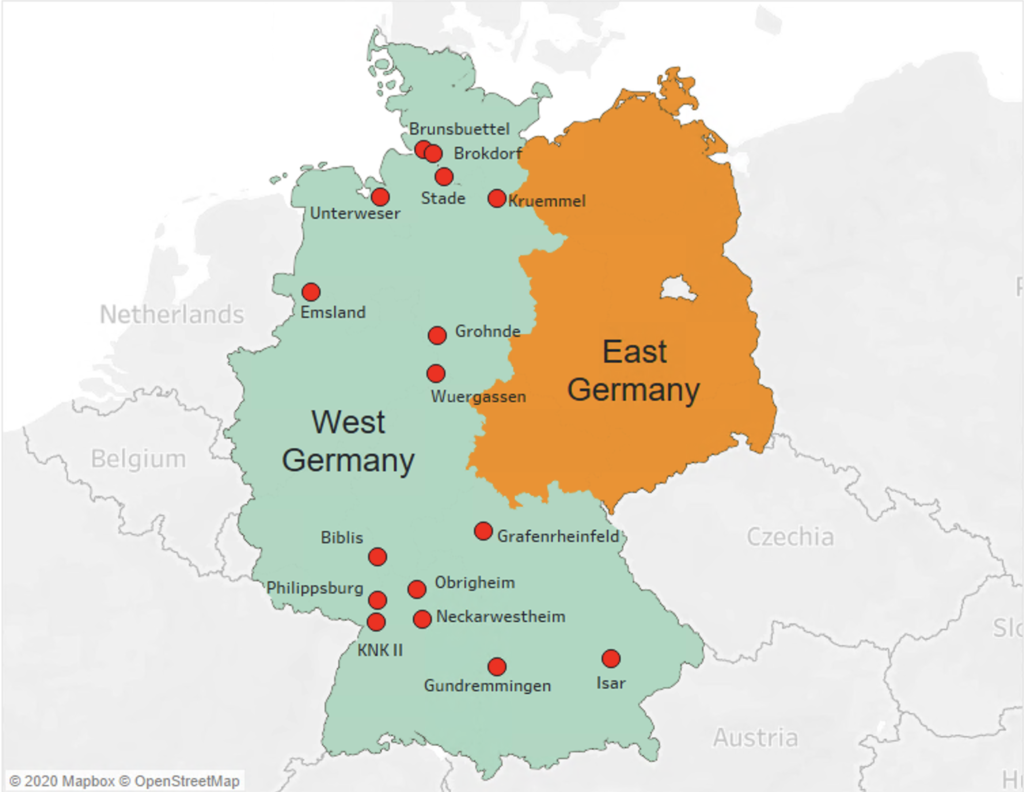 September 1990
September 1990
Drag slider handle to compare.
When Germany united on October 3, 1990, there were 16 nuclear power plants in operation, two of which were permanently shut down in East Germany right before unification. At the time of reunification, Germany became responsible for SNF stored at plants in both the East and West.
Czechoslovakia vs. Czech Republic and Slovakia
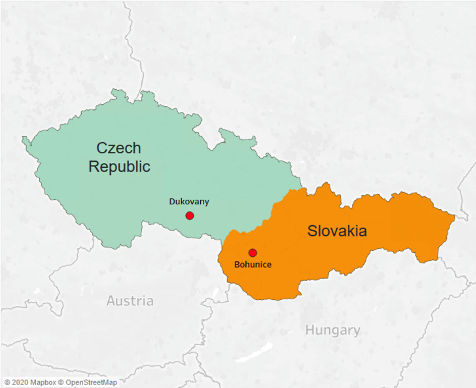 February 1993
February 1993
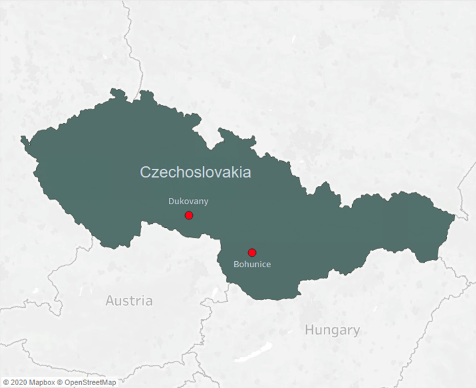 December 1992
December 1992
Drag slider handle to compare.
On January 1, 1993 Czechoslovakia was dissolved into the Czech Republic and Slovakia. At the time of the change, there were two nuclear power plants within Czechoslovakia, Dukovany and Bohunice. They began operation in 1985 and 1980, respectively. Due to their locations, the Czech Republic acquired Dukovany and Slovakia acquired Bohunice. The Czech company that now operations Dukovany and is responsible for its SNF storage did not exist at the time of the plant’s construction.
Spent Fuel is Stored at Hundreds of Sites
Nearly 300 different locations serve as storage for spent nuclear fuel. The sheer number of sites poses safeguards, security, and safety risks.
SNF is currently stored in a country’s central interim storage or on-site storage at nuclear reactors, either in wet or dry storage. To date, there are 293 SNF sites located in 39 countries.3Although there are 53 countries with nuclear reactors, there are 39 countries reporting their SNF storage sites in the national reports for the IAEA 6th Joint Convention on the Safety of Spent Fuel Management and on the Safety of Radioactive Waste Management, 2018. Of these, there are 6 countries (France, Germany, Hungary, Sweden, Switzerland, Ukraine) that have operational central storage facilities. As efforts towards finding long-term solutions for isolation and permanent disposal of SNF continue around the world, a global picture of the current status of SNF distribution provides context for spent fuel management strategies.
Since 1960, countries’ SNF inventories have fluctuated due to the numbers of reactors going on-line and off-line. But the trajectory is clear. Understanding a trend in the change of SNF over time could help countries determine their long-term strategies for SNF management.
Country Fact Sheets:
Global Spent Nuclear Fuel Tracker (1960-2050)
SNF in Tonnes of Heavy Metal (tHM)
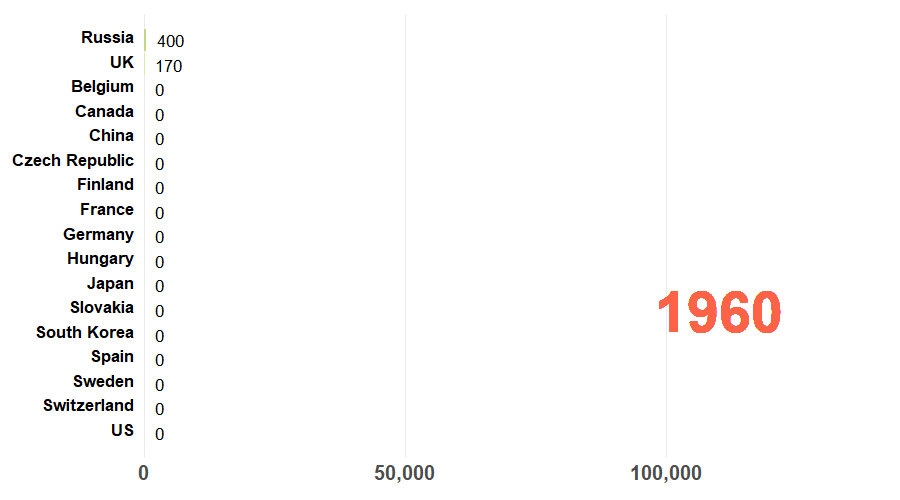
How spent fuel is managed, and the types of nuclear reactors used by a country can affect how rapidly the amount of spent fuel in storage increases. For example, Russia, France, UK, and Japan partially reprocess their civilian spent fuel, extracting uranium and plutonium from it for reuse, and leaving less in storage. Others, such as Canada, Finland, and Sweden, have chosen to store spent fuel since it was produced. The amount of SNF also depends on the types of nuclear reactors. Canada has pressurized heavy-water reactors (CANDU reactors) that produce more spent fuel than other types due to a low burn-up rate.
As efforts towards finding long-term solutions for isolation and permanent disposal of SNF continue around the world, a global picture of the current status of SNF distribution provides context for spent fuel management strategies.
Where is nuclear fuel stored today?
This interactive map provides a snapshot of existing nuclear power plants, research reactors and SNF inventories by region in 17 countries around the world
To move around the interactive map, refer to the tools in the top left corner. Zoom in for a closer look at the SNF sites and hover over a site point or region for more information.
This map shows the spread of relevant facilities in 17 countries around the world and visualizes the concentration of SNF inventories in subnational regions of interest. By displaying SNF inventory in subnational regions rather than at specific facilities or in countries as a whole, it provides a more useful look at how SNF is concentrated in larger areas and distributed within countries. The degree of subnational regional division differs between some countries to account for the wide range of inventory masses present in the selected countries. Divisions are also dependent on the specific pre-set country divisions available in the Tableau visualization tool. Tableau’s mapping function offers the ability to group predefined geographical areas into regions of interest and present the regional SNF information by color shading. Based on these specifications, the U.S. is broken into regions (West, Central, East, South) rather than states because not every state has SNF, and facilities are less clustered in the West and Central areas. Canada is divided regionally with the exception of Ontario, in part due to the large inventory in Ontario, which houses the majority of Canadian reactors and is the focus for disposal efforts. The Western and Northern Canada region houses research reactor SNF, while SNF in Quebec and Eastern Canada is from operational and decommissioned reactors.
The SNF regions, therefore, are intended to harmonize different geographical boundaries while maintaining easy visualization of wide-ranging SNF inventories in our selected countries. This approach synthesizes different methods of national reporting while maintaining a degree of sensitivity around the data national authorities provide.
Knowing the relative distribution of nuclear facilities and SNF could assist countries’ regulatory bodies and the IAEA in planning verification activities and developing a holistic approach for permanent storage and final disposal of SNF. This might also help foster international collaborations for those countries that share the same interest in long-term SNF solutions.
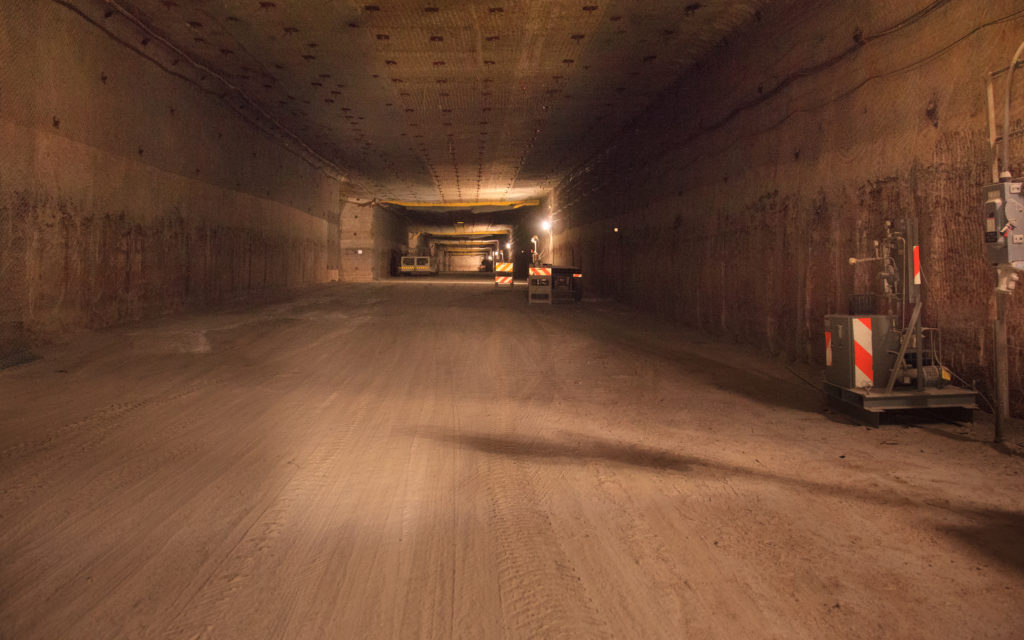
Deep underground storage is a potential long-term storage solution
Current wet and dry spent fuel storage systems on the surface can operate for between 50 and 100 years. But as the volume of fuel grows, current storage facilities will soon reach their capacity. This intensifies the need to develop new facilities to handle storage and permanent disposal of nuclear waste. Deep geological repositories (DGRs) have long been considered the safest option to keep SNF safe and secure. Some States such as Finland, Sweden, France, and Switzerland are moving towards permanent disposal at DGRs. The world’s first DGR will begin operations in Finland around 2025.
A few models for future deep geological repositories have been proposed and examined during the past decades using a traditional tunneling method. KBS-3 and Multi-barrier designs, as described below, are examples of this method. Lately, a deep horizontal drillhole repository design, which is based on innovative directional drilling method, also has been proposed for permanent disposal of spent nuclear fuel.
Deep Geological Repository Designs/Concepts
Multi-barrier Repository Concepts
In this concept, geological disposal provides safety through a combination of man-made (engineered) and natural barriers that work together to provide isolation and containment of radioactive waste. The barriers in the multibarrier concept include solid-only waste form, waste container, a buffer or backfill, access seals, and host rock. Together, these barriers will provide multiple levels of protection from the waste for many thousands of years.
KBS-3, A multi-barrier-based design
A type of multi-barrier repository, the KBS-3 (kärnbränslesäkerhet) concept is a technology for disposal of high-level radioactive waste developed at Svensk Kärnbränslehantering Aktiebolag (SKB)-the Swedish Nuclear Fuel and Waste Management Company. The disposal method consists of storing the waste in intermediate storage for 30 years, encapsulating the waste in cast iron inserts in copper-clad canisters and then depositing the capsules in bentonite clay, in an 8 m deep and 2m wide circular vertical hole at 500 m down into crystalline bedrock. After the storage facility is full, the drilled hole is sealed. Sweden and Finland are using the KBS-3 design concept for their prospective DGRs.
Source: Presentation “National strategy and roadmap for geological disposal in Finland” for Stimson site visit, STUK, 2018.
Swiss Multi-Barrier Safety System
A multi-barrier safety system is studied at National Cooperative for the Disposal of Radioactive Waste (Nagra), Switzerland. The system contains Waste matrix of UO2 and MOX pellets within their cladding for SNF and glass for high-level waste , corrosion-resistant (copper-coasted) canister with a 1000-year lifetime, ore-compacted granulated bentonite for backfilling and host rock (Opalinus Clay). Under Swiss Nuclear Energy Law and Nagra’s Waste Management Program, the multi-barrier concept is viable for deep geological disposal in Switzerland. The option for a co-hosting geological disposal facility within the framework of a bilateral or multilateral project is being kept open under very strict conditions, but not actively pursued.
Deep Horizontal Drillhole Repository Concept
Deep Isolation – a US-based company – is studying a novel idea to drill horizontal boreholes to permanently dispose of SNF at a much lower cost than tunneling designs. This drilling technique begins with a vertical access drillhole extending thousands of feet deep and will then gently turn horizontal. Canisters containing spent nuclear fuel and high-level waste stored in the deep horizontal section would be around 18-inch in diameter. The waste canisters are retrievable, and there is no need for humans to go underground.
Source: Disposal of High-Level Nuclear Waste in Deep Horizontal Drillholes, Deep Isolation, 2019
Multinational Geological Repository
Multinational geological repositories (MGRs) are DGRs characterized by participating countries that jointly develop a repository framework with or without a host country. Whether a host would be identified at an early or later stage, all financial and administrative responsibilities could be placed in a multinational group with participation restricted to a select group of States or on a commercial basis from other countries. Alternatively, an ‘add-on scenario’ could be envisioned where a host country developing its own national repository accepts nuclear material from other countries at a later stage. MGRs could be constructed using either multi-barrier safety concept or deep horizontal drillhole concept.
Nuclear safeguards will have to keep up with these new facilities and technologies
Spent fuel is protected from misuse by the nuclear safeguards system. This web of international treaties, multilateral organizations, and state regulators together create obligations on facilities for reporting, inspection, and use. New types of facilities, like deep geological repositories, will create challenges for safeguards implementation. The safeguards community will have to keep pace with these changes.
A robust safeguards management system assists SNF management facilities in ensuring that spent fuel is not misused or diverted from peaceful uses. While nuclear safeguards are the set of technical measures used by the IAEA to verify that States are not misusing or diverting their nuclear material, nuclear security is the prevention and detection of (and response to) theft, sabotage, and unauthorized access, or illegal transfer of nuclear material, other radioactive substances or their associated facilities. The former is governed by the agreements States have with the IAEA as per the Nuclear Nonproliferation Treaty (NPT). The latter is a State responsibility, meaning the IAEA does not conduct nuclear security inspections (national regulators will inspect as per domestic regulations).
DGRs will take decades to plan and many more decades to construct due to technical, legal, societal, economic and political aspects. Thus, the long timelines of underground disposal will require the consideration of safeguards implications for DGRs and MGRs, especially with evolving technologies that support safeguards verification. It also requires the forecasting of several scenarios regarding the future global political landscape and its nuclear risks, and the potential for the nuclear non-proliferation regime to respond.
Methodology & Disclaimer
Our approach combines methodologies of archival research and calculations based on existing
data and/or reactor specifications when archival data for a facility or country is not available.
Archival research
Our main sources are:
- The national reports submitted by countries as per the IAEA Joint Convention on the Safety of
Spent Fuel Management and on the Safety of Radioactive Waste Management, - Situation reports on radioactive waste and spent fuel management in the European Union,
- IAEA Power Reactor Information System (PRIS),
- IAEA International Nuclear Information System (INIS)
- IAEA Country Nuclear Power Profiles (CNPP)
Other useful sources are from World Nuclear Association; OECD Nuclear Energy Agency; Canada NWMO; US Energy Information Administration; European Environment Agency; International Panel on Fissile Materials (IPFM); Scientific website and Journal: ScienceDirect, The National Academies of Sciences, Engineering & Medicine – The National Academies Press (NAP), The Asia-Pacific Journal-Japan Focus.
Calculation methods
There are three main methods being applied
- Linear Extrapolation We estimate the data between 2 known data points by linear extrapolation under a condition that the number of nuclear reactors is relatively constant. Benchmark: Take Finland SNF data In 20131 and 20162 , Finland has 1934 and 2098 tHM of SNF, respectively. Using this method, we estimate SNF inventories for 2014 (1988.7 tHM) and 2015 (2043.4 tHM).
- Calculation based on known annual SNF arising, reprocessing, imported or exported Cumulative SNF of year X = SNF in storage in year X-1 + New SNF produced – SNF reprocessed + SNF imported – SNF exported
- Calculation based on reactor characterization Assume that the initial total heavy metal core loading is approx. equal to the final total heavy metal discharge. Total heavy metal core loading (in grams) can be estimated by
(Net Capacity (in MWe))/(Thermal Efficiency) x (unit capacity factor * (365 days/year) * (# of operation years))/(Enrichment (%))
- unit capacity factor is the unitless ratio of an actual electrical energy output over a given period of time to the maximum possible electrical energy output over that period
- thermal efficiency is the percent of thermal energy converting into electric energy
- Enrichment is the percentage of U-235 isotope in the nuclear fuel
Reactor characterization information4See p.5-10. https://inldigitallibrary.inl.gov/sites/sti/sti/5554578.pdf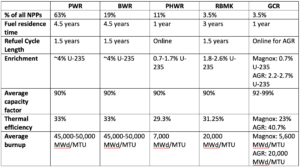
(Click on table to Zoom)
Note: An enrichment of 4-4.5% would be burned to about 45,000 MWd/MTU. An enrichment of 3% would be burned to about 33,000 MWd/MTU
Benchmark Assumption:
- Max Fuel Burnup = 33 MWd/kgU
- 1 g U235 can produce 1 MWd
- Fuel is enriched to 3%
- Plant capacity factor is 90%
- Plant produces 1000 MWe @ 33% efficiency
- Average fuel residence is 3 years
Step 1 – Convert MWe to MWth: 1000 MWe/.33= 3000MWth 3 See p.5-10. https://inldigitallibrary.inl.gov/sites/sti/sti/5554578.pdf
Step 2 – Find total MWd produced over 3 years: 3000 MWth * 365.25days * 3 years * .9 capacity factor = 2958525 MWd
Step 3 – If 1 g U235 can produce 1 MWd, we would need 2958525 g U-235 to produce 2958525 MWd
Step 4 – If our fuel is enriched to 3%, then 2958525 g U-235 /0.03 = 98617500 g Uranium = 99 metric tons
Step 5 – We know that the fuel is burnup limited to a 3-year residence time, so we can assume that 1/3 of the core is expelled every year. While some Uranium is being converted to other nuclides, we can assume that the total weight of those elements is similar (MTU is approx. tHM in fuel).
Step 6 – Annually, the hypothetical LWR reactor would discharge 1/3 of the 99 MTU, which equals approximately 33 tHM of spent fuel.
All data gathered is from open, public sources and will be distributed to public audience.
Assumptions made in the data analysis are not reflective of the position of any nuclear facilities. Methods described in this project are peer-reviewed but they are only relevant in the context of this mapping project. Some SNF inventory data is estimated using our calculation methods and therefore there are some errors associated with our data within 10% uncertainty.

